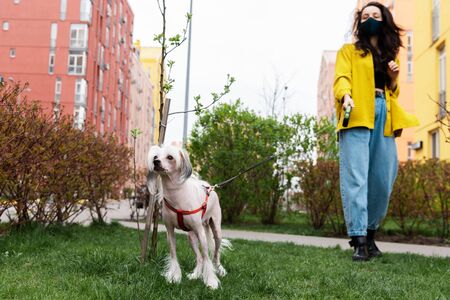1. Choosing the Right Breed and Fitness Level
Not all dogs are natural runners. Some breeds thrive on endurance activities, while others may struggle with long-distance running. Before you start jogging with your dog, its important to assess their breed, age, and overall health condition.
Understanding Your Dogs Breed
Certain breeds are built for running, while others are better suited for short walks or moderate activity. Below is a general guide to help determine if your dogs breed is suitable for jogging:
| Breed Type | Running Capability | Example Breeds |
|---|---|---|
| High-Energy Endurance Runners | Great for long-distance running | Border Collie, Labrador Retriever, Weimaraner |
| Moderate Joggers | Good for short to medium runs | Boxer, Dalmatian, Standard Poodle |
| Short-Distance Sprinters | Better for quick bursts of activity | Greyhound, Jack Russell Terrier, Whippet |
| Low-Energy or Brachycephalic Breeds | Not ideal for running due to breathing or joint issues | Bulldog, Pug, Shih Tzu |
Considering Age and Health Condition
Puppies and senior dogs may not be the best jogging companions. Puppies’ bones and joints are still developing, and high-impact exercise can cause long-term damage. Senior dogs may have arthritis or other health conditions that make running uncomfortable.
Puppy Considerations
If you have a young dog, wait until they reach full skeletal maturity before starting a running routine. This can vary by breed but generally occurs between 12-18 months for most dogs.
Senior Dog Considerations
If your dog is older, check for signs of discomfort like limping or heavy panting after mild exercise. Always consult with your veterinarian before introducing a new fitness routine.
Checking Your Dog’s Health Before Running
A visit to the vet is always a good idea before starting any new exercise program. Your vet can assess heart health, joint condition, and overall fitness level to ensure your dog is ready for regular jogging sessions.
Signs Your Dog May Not Be Ready for Running:
- Panting excessively after short walks
- Limping or stiffness after exercise
- Poor stamina or reluctance to move forward during walks
- Frequent stopping or lying down during activity
- Difficulties breathing (especially in brachycephalic breeds)
By carefully evaluating your dogs breed, age, and health condition, you can create a safe and enjoyable jogging experience that benefits both you and your furry companion.
2. Prepping for a Successful Run
Before hitting the trail, ensure your dog is properly hydrated, has a comfortable harness or leash, and is familiar with basic commands for a safe and enjoyable experience. Proper preparation will help both you and your pup build endurance safely while preventing unnecessary stress or injury.
Hydration Is Key
Just like humans, dogs need to stay hydrated before, during, and after a run. Always bring fresh water and a collapsible bowl so your pup can drink as needed. Dehydration can lead to serious health issues, so keep an eye out for signs like excessive panting, dry gums, or lethargy.
Signs of Dehydration in Dogs
| Sign | Description |
|---|---|
| Excessive Panting | Your dog breathes heavily even when not exerting much energy. |
| Dry Gums | The gums feel sticky or dry instead of moist. |
| Lethargy | Your dog seems unusually tired or uninterested in activity. |
| Loss of Skin Elasticity | If you gently pinch their skin and it doesn’t snap back quickly, they may be dehydrated. |
The Right Gear Matters
A well-fitted harness or leash is essential for comfort and control. Avoid using retractable leashes, as they can make it harder to manage sudden movements. Instead, opt for a hands-free waist leash or a standard 4-6 foot leash for better control.
Recommended Running Gear for Your Dog
| Gear | Description |
|---|---|
| No-Pull Harness | A comfortable harness that reduces strain on your dogs neck. |
| Bungee Leash | A shock-absorbing leash that helps minimize pulling impact. |
| Paw Protection Wax or Booties | Keeps paws safe from hot pavement or rough terrain. |
| ID Tags/Microchip | Makes it easier to locate your pet if they get lost during a run. |
The Importance of Basic Commands
Your dog should understand basic commands like “heel,” “leave it,” and “stay” before running in public areas. This ensures they remain safe around distractions such as other runners, cyclists, or wildlife.
Main Commands to Teach Your Dog Before Running:
- “Heel”: Encourages your dog to stay by your side instead of pulling ahead.
- “Leave it”: Helps prevent them from picking up harmful objects on the ground.
- “Stay”: Useful for stopping at intersections or avoiding obstacles.
- “Come”: Ensures your dog returns to you if they get distracted.
Pacing and Warm-Up Exercises
Avoid starting too fast—just like humans, dogs need time to warm up. Begin with a brisk walk or light jog before increasing speed. Pay attention to their breathing and body language to ensure they are comfortable with the pace.
A Simple Warm-Up Routine:
- Start with a 5-minute walk: Allows joints and muscles to loosen up.
- Add gentle stretches: Encourage your dog to do play bows or slow leg stretches before running.
- Smooth transition into jogging: Gradually increase speed rather than starting abruptly.
- Pace based on fitness level: Younger dogs may have more energy, while older dogs may need slower speeds.
A little preparation goes a long way in ensuring an enjoyable and safe run with your dog. By focusing on hydration, proper gear, training, and warming up correctly, youll set both yourself and your furry friend up for success!

3. Gradual Training and Endurance Building
When introducing your dog to jogging or running, its essential to start slow and gradually build up their stamina. Just like humans, dogs need time to develop endurance and strength to avoid injuries or exhaustion.
Start with Short Sessions
Begin with short jogs or brisk walks before increasing the distance and intensity. A good starting point is 5–10 minutes per session, depending on your dogs fitness level.
Increase Duration Gradually
As your dog becomes more comfortable, gradually add a few minutes to each session every week. Avoid sudden jumps in distance or speed, as this can lead to muscle strain or joint issues.
Sample Weekly Training Plan
| Week | Duration | Pace | Notes |
|---|---|---|---|
| Week 1 | 5–10 minutes | Brisk walk/jog mix | Observe energy levels |
| Week 2 | 10–15 minutes | Mild jog | Ensure proper hydration |
| Week 3 | 15–20 minutes | Sustained jog | Add short breaks if needed |
| Week 4+ | Add 5 mins per week | Mild to moderate pace | Avoid overexertion signs |
Pacing Based on Your Dog’s Breed and Age
Larger breeds may have more stamina for longer runs, while smaller dogs may need shorter bursts of exercise. Puppies and senior dogs require extra care—always adjust based on their abilities.
Avoid Overtraining and Watch for Signs of Fatigue
If your dog starts lagging behind, panting excessively, or showing reluctance to continue, take a break. Pushing too hard can lead to exhaustion or injuries.
The Importance of Rest Days
Your dog needs rest days just like humans do. Incorporate at least one or two rest days per week to allow muscles to recover and prevent overuse injuries.
4. Weather Considerations and Safety Precautions
When jogging or running with your dog, weather conditions play a crucial role in their safety and performance. Factors like temperature, humidity, and terrain can significantly impact how well your dog handles the activity. Being mindful of these elements will help prevent overheating, dehydration, and paw injuries.
Understanding Temperature and Humidity
Dogs are more sensitive to heat than humans because they rely on panting to cool down. High temperatures and humidity levels can quickly lead to overheating. Here’s a quick guide to safe running temperatures for dogs:
| Temperature (°F) | Running Safety |
|---|---|
| Below 50°F | Safe for most dogs, but short-haired breeds may need extra warmth. |
| 50-70°F | Ideal temperature range for running. |
| 70-80°F | Caution: Some dogs may struggle, especially brachycephalic breeds. |
| 80-90°F | Poor conditions: Risk of overheating; limit exercise. |
| 90°F and above | Dangerous! Avoid running, as heatstroke is highly likely. |
Paw Protection and Terrain Awareness
The surface you run on affects your dogs paws. Hot pavement, rough trails, and icy paths can cause discomfort or injury. Always check the ground before heading out:
- Pavement Test: Place your hand on the pavement for five seconds. If its too hot for your hand, its too hot for your dogs paws.
- Terrain Choice: Grass and dirt trails are softer on paws compared to asphalt or concrete.
- Paw Care: Consider using dog booties or paw balms for extra protection.
Avoiding Dehydration and Overheating
Your dog needs frequent water breaks to stay hydrated during runs. Watch for signs of overheating such as excessive panting, drooling, or lethargy. To keep your pup safe:
- Cary Water: Bring a collapsible bowl and fresh water for your dog.
- Avoid Peak Heat Hours: Run early in the morning or late in the evening when temperatures are cooler.
- Tune Into Your Dog: If they slow down or seem tired, take a break immediately.
Sunscreen for Dogs?
If your dog has a short coat or light-colored fur, they may be prone to sunburn. Use pet-safe sunscreen on exposed areas like the nose, ears, and belly before heading out in sunny weather.
The Bottom Line on Weather Safety
Your dogs comfort should always come first when running together. Adjust your pace, distance, and schedule based on the weather to ensure a safe and enjoyable experience every time you hit the trail.
5. Post-Run Care and Recovery
After a good run, your dog needs proper care to recover safely. Paying attention to hydration, stretching, and checking for injuries can help prevent discomfort and ensure they’re ready for the next outing.
Hydration: Keep Your Dog Refreshed
Just like you need water after a run, your dog does too. Offer fresh water immediately after your jog to help them cool down and rehydrate. If it was a long or intense run, consider an electrolyte supplement designed for dogs.
Gentle Stretching for Muscle Recovery
Light stretching can help relax your dogs muscles and reduce stiffness. Try gentle leg extensions or massaging their legs and shoulders to promote circulation.
Check for Potential Injuries
Inspect your dog’s paws for cuts, cracks, or debris stuck between their pads. Also, watch for any signs of limping or sensitivity when touching their legs and joints.
Signs of Overexertion
Its important to recognize when your dog might be overworked. Here are some common signs of overexertion:
| Sign | Description |
|---|---|
| Panting excessively | Your dog continues heavy panting even after resting. |
| Limping or stiffness | Your dog is reluctant to walk or shows discomfort. |
| Pale or bright red gums | An indication of dehydration or heat exhaustion. |
| Lack of energy | Your dog seems unusually tired and uninterested in normal activities. |
How to Respond If Your Dog Shows Signs of Overexertion
- Provide Water: Offer small amounts of cool water but avoid letting them drink too quickly.
- Move to Shade: If it’s hot outside, get them out of direct sunlight and into a cooler area.
- Let Them Rest: Allow your dog to lie down and relax until they regain energy.
- If Symptoms Persist: Contact your vet if your dog doesn’t improve within 30 minutes.

